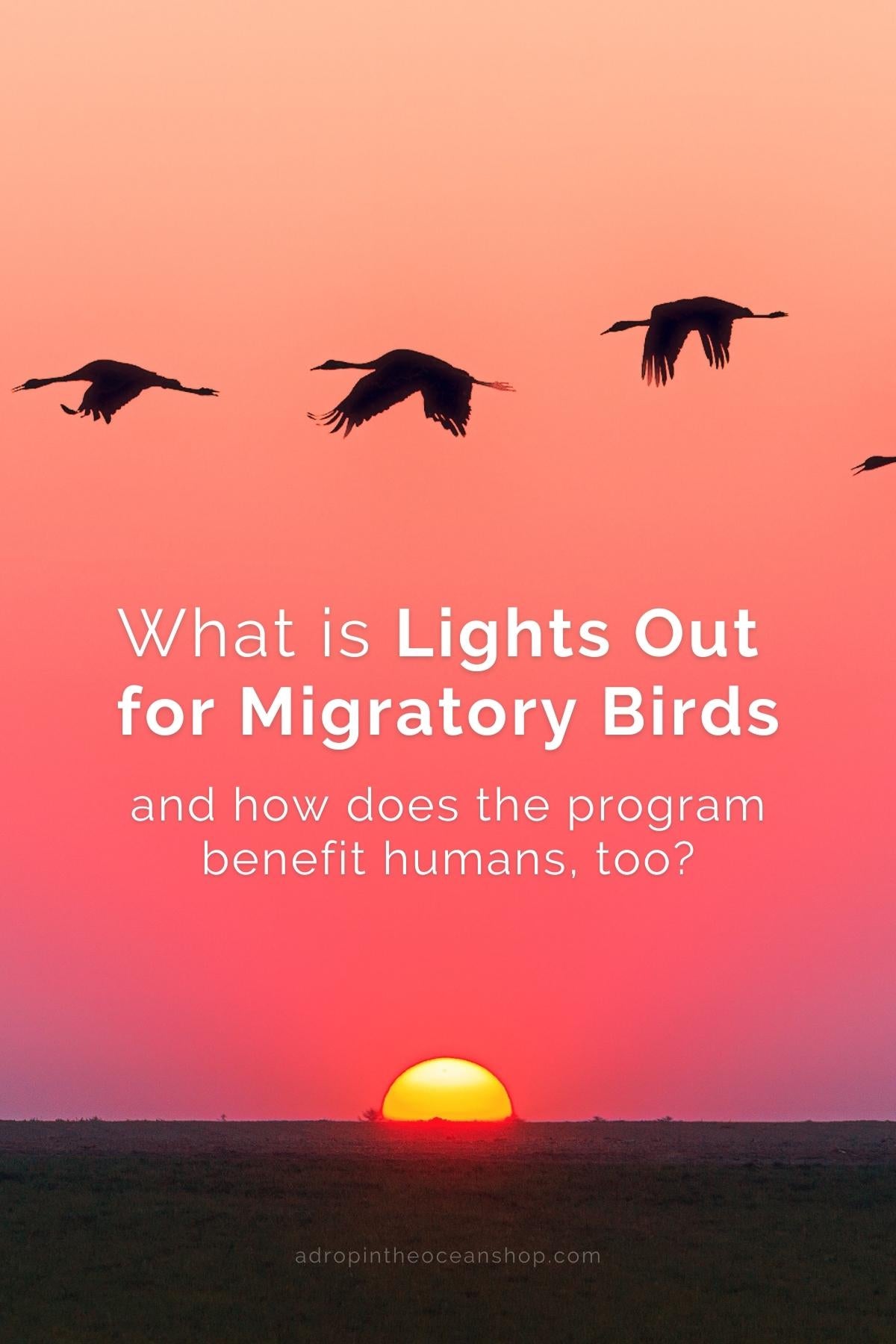What is the Lights Out for migratory birds program + how does it benefit humans, too?

This post first appeared in our weekly Make Waves Mondays email series on December 13, 2021.
Hello hello hello, friend!
I’m pretty excited about today’s topic, so we’re gonna dive right in 😁
As you may know, in my previous life I worked as the Conservation Specialist at the Columbus Zoo and Aquarium, and during my time at the Zoo, some coworkers from across the Animal Care, Conservation, and Sustainability departments came together to work with Columbus Audubon to promote and contribute to Audubon’s Lights Out initiative.
At the time, this was the first I’d heard of Lights Out, as my wildlife interests fell mostly with African megafauna at the time (lions, in particular, were my animal love), and Lights Out was all about migratory birds.
But the more I heard about the program, the more interested I became. And I discovered just how important programs such as these are for our wildlife - and for ourselves.
So today I wanna share with you a bit about Lights Out, why it matters, and what we can all do to protect migratory birds from the comfort of our own homes.
Let’s start from the beginning...
What are migratory birds and why are they important?
Migratory birds are birds that travel from one place to another regularly (migrate), typically over long distances. Every year, billions of birds migrate across these long distances.
For example, sandhill cranes typically breed in Canada and the northern United States, and migrate south to Texas, Florida, Utah, California, and Mexico for the winter. I mean…just look at how far they fly every year!

Sandhill crane spring migration path. Image from Crane Trust.
Birds are typically indicator species, meaning they can indicate environmental health.
Their visibility makes them pretty easy to study, and they’re sensitive to environmental contaminants. Think “canary in a coal mine,” or the fact that we discovered DDT was dangerous because bald eagle eggs - among other bird species - were becoming incredibly thin and couldn’t handle the weight of the incubating adult.
So...birds are kinda important.
But protecting birds also means we’re protecting our own environments.
Across the globe, birding is a particularly popular hobby, and has a strong impact on our economy.
According to the US Fish and Wildlife Service, 45 million people consider themselves “birders,” whether around their own home or traveling. These 45 million people contribute nearly $80 billion to the US economy each year through purchasing bird food, feeding equipment, travel accommodations, attending festivals, and more.
Even hunting waterfowl is an important piece of wildlife and environmental conservation. Yes, really.
All waterfowl hunters over the age of 16 are required to purchase a duck stamp, which acts as a hunting license, but also is a huge contributor to wetland conservation.
A whopping 98% of duck stamp sales go directly to helping acquire and protect wetland habitat and purchase conservation easements for the National Wildlife Refuge System. Wetlands could be their own blog topic; they’re so critical to our ecosystems and natural environment.
To date, $950 million in revenue from Duck Stamps has helped acquire and protect 6 million acres of habitat.
(P.S. You don’t have to be a hunter to purchase a duck stamp! You can purchase your own duck stamp each year as a way to contribute directly to conservation efforts.)
(P.P.S. Duck stamps are actually really freaking cool. Should I do a full blog on duck stamps and why they’re awesome-possum? Let me know what you think!)

2021-2022 Federal Duck Stamp (Image from US Fish and Wildlife Service)
How does light affect migratory birds?
Most migratory flight happens at night, using the magnetic pull from the earth and the moon and stars to set the path.
Lights can disorient birds, causing them to circle for hours and land in unsafe urban environments during the day, or simply tire out and collapse from exhaustion. They can also increase window collisions, leading to even greater rates of bird mortality.
If birds can’t orient to the moon and stars, their migrations are made immensely more difficult.
How does light affect us as humans?
Artificial lighting doesn’t just impact birds.
While the shift to LEDs is great for saving energy, it’s actually impacting our health in negative ways.
According to the American Medical Association, LED light suppresses melatonin at night, and is five times worse for our sleep cycles than conventional light.
In residential areas with more light at night, studies have shown reduced time asleep, lowered sleep quality, impaired functioning during the day, and even obesity.
Some studies have even shown a link between nighttime light exposure and diabetes and heart disease, and a study from the University of South Florida found that when birds are exposed to artificial light, they can incubate West Nile Virus for twice as long, which can increase the presence of WNV in our communities.
So, clearly, this is more than just a problem for the birds.
What is Lights Out?
Lights Out is an initiative from the National Audubon Society working with building owners, managers, and residents, encouraging them to turn off unnecessary building lights at night.
It began in 2001 in Chicago when birder Robbie Hunsinger attended a presentation by the director of the Fatal Light Awareness Program, which was founded in Toronto a decade prior. Inspired by the presentation, Hunsinger began working directly with building managers in Chicago to turn off their lights, and by 2004 every building taller than 60 stories in Chicago was turning off their lights for migratory birds.
(So...ya know...whenever you feel like one person can’t make a difference, I want you to remember this.)
A few years later, Lights Out was officially established in Chicago in 1999, and dozens of cities across the US have taken on the initiative too.
And the program is clearly a successful one. One building in Chicago saw 30,000 bird collisions over a 20-year period, but through Lights Out, bird mortality has decreased by more than 80%!

A little mallard duck chick, because they’re just too cute.
What can we do to protect migratory birds?
If you’re sitting here like, “This is great, Krystina, but what can I do as an individual??” you know I gotchu.
If you work in an office building, or live in an apartment building, particularly a tall one, talk to your building manager about the Lights Out program. Find out what’s already being done, and offer resources for improvements. If not for birds, the money-savings and potentially positive press associated with the changes may be a convincing factor.
If nothing else, upper-level lighting is most critical, and Audubon even has a sample letter to help get in contact with building managers we can use!
And when you’re at home…
- Turn off exterior lights, or ensure they’re shielded and lower the brightness
- Install motion sensors on exterior lights
- Choose lights with warm color (3000 Kelvin rating and under)
- Close your blinds or curtains at night
And of course, write to your elected officials! Check out Audubon’s sample letter for writing to elected officials that makes it easy peasy. The more you can personalize the letter to express why you care, the better.
And finally, check if your city has a Lights Out program and get involved! Join or contribute to your local Audubon Society chapter. If your local chapter doesn’t already have a Lights Out program, learn about the other programs they have and contribute to those, too.
Now I’m curious, friend, were you already familiar with Lights Out, or was this all new to you? What’s one thing you’ll commit to doing to protect migratory birds in the coming year? As always, I’d love to hear from you, so comment below and let’s chat!









Leave a comment